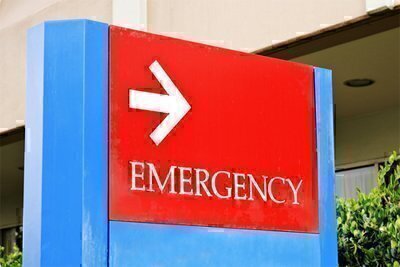What to Do If the Case Is Urgent but Not Life-Threatening
Last updated November 2015
 The most difficult decisions involve cases in which you feel safe waiting 30 minutes or more to receive care, but still require treatment at a hospital, rather than at an urgent care clinic or doctor’s office. In these cases, you can generally do without an ambulance; a car or taxi will suffice. But you may prefer an ambulance if—
The most difficult decisions involve cases in which you feel safe waiting 30 minutes or more to receive care, but still require treatment at a hospital, rather than at an urgent care clinic or doctor’s office. In these cases, you can generally do without an ambulance; a car or taxi will suffice. But you may prefer an ambulance if—
- The patient and those assisting him or her are too upset to drive; using an ambulance is comparatively easy.
- Medical skill may be needed to move the patient (for example, if there is a possible fracture).
On the other hand, there are good reasons not to use an ambulance—
- By providing your own transportation, you control the choice of hospital. In an ambulance, even if the ambulance squad considers a patient’s preference, hospital choices likely will be limited to the two or three closest hospitals.
- You ensure that the emergency department will not turn you away. Concerns about legal liability make it difficult for hospitals to turn individuals away at the door. In contrast, ambulances are easily turned away. The emergency department simply claims to be overcrowded and asks that ambulances be put on “reroute.” Thus, in an ambulance you may be shunted to a more distant hospital, which has a more responsible policy on keeping its emergency department open but is equally overburdened.
 Ambulances often charge fees. Even if you have insurance coverage, you might have to pay all or a portion of the fee.
Ambulances often charge fees. Even if you have insurance coverage, you might have to pay all or a portion of the fee.
Assuming you do provide your own transportation, or your ambulance service allows you to choose a hospital, you have the opportunity—and the burden—of making that choice. A good strategy is to have the patient’s doctor choose for you. There is usually time to call the doctor, who probably has a general sense of the medical capabilities of different emergency departments and knows which are easiest to communicate with on follow-up.
A call to the patient’s doctor also makes sense for other reasons:
- The doctor will be able to tell you whether to call an ambulance and what first aid to administer.
- The doctor may call the emergency department and smooth the way for your arrival. This may eliminate a lot of red tape because tests can be ordered right away, without having to wait to see an emergency department physician. The doctor may also specify conditions under which a specialist should be called in—and perhaps who that specialist should be.
- The patient’s doctor may be able to tell you not to bother with the emergency department—to wait for a regular office visit or to visit an urgent care clinic.
If you can’t reach the patient’s doctor, or he or she doesn’t have one, or if you want to have a role along with the doctor in emergency department selection, our Ratings Tables provide information that will help.
The right choice in an urgent but not life-threatening case depends mainly on the complexity of the case. Let us (somewhat arbitrarily) divide cases into three categories:
- Simple cases. You know what is wrong and know that the treatment is simple—for instance, a laceration that may require stitches (other than on the face).
- Complex cases. You know what is wrong and know that treatment will require considerable skill—for instance, severely crushed fingers or a badly lacerated face.
- Cases in which you don’t know. You aren’t sure what is wrong or how complex the problem is—for instance, an unusual abdominal pain that has become increasingly severe over a period of a few hours, or the patient experiencing shortness of breath following several days with a cold.
Simple Cases
 The fact that a case is simple does not mean it can’t be very uncomfortable. And choosing the wrong hospital (or the right hospital on the wrong day) can make the experience miserable. Your major considerations for these cases are convenience and pleasantness.
The fact that a case is simple does not mean it can’t be very uncomfortable. And choosing the wrong hospital (or the right hospital on the wrong day) can make the experience miserable. Your major considerations for these cases are convenience and pleasantness.
Other patients are an excellent source of guidance when choosing an emergency department for simple cases. Our Ratings Tables show how area consumers (primarily Checkbook and Consumer Reports subscribers) rated hospital emergency departments they had used on the following criteria: “overall quality of care,” “speed of service,” “staff pleasantness,” “effort to relieve patient’s discomfort and anxiety,” “listening to/communicating with patient,” and “helpfulness in arranging follow-up care.” Click here for more information on our customer survey and other research methods.
Our Ratings Tables also report results of a survey in which physicians told us which hospital emergency departments they considered “most desirable” and which they considered “least desirable” “for emergency treatment of minor injuries.” Our Ratings Tables show, among the physicians who mentioned each hospital, what percentage considered it “most desirable.”
If your case is simple, you want to obtain treatment and go home as quickly as possible. In addition to the ratings from patients on “speed of service,” our Ratings Tables report data on hospital emergency departments from the federal government’s Hospital Compare website, which includes six measures related to the speed of service:
- Average number of minutes patients waited to be seen by a healthcare professional
- Average number of minutes patients spent in ER before decision was made to admit them
- Average number of minutes patients waited to get to their rooms after decision to admit was made
- Average number of minutes it took ER to treat patients and send them home, if not admitted
- Average number of minutes patients with broken bones waited to receive pain medication
- Percent of hospitals’ patients who left the ER without being seen
For simple cases, you can call various emergency departments to ask about wait times before making a choice. Some hospitals now post average wait times on their websites. Keep in mind the estimates provided on websites usually take into account how long patients wait to see a doctor, physician’s assistant, or nurse who provides care, but usually don’t indicate how long it will take the hospital to treat you and get you out the door.
Complex Cases
Your best choice of facility might be quite different in cases that require complex treatment.
An Overall Quality Indicator
Our Ratings Tables show results from our surveys of area physicians who were asked which area hospitals they considered “most desirable” and which they considered “least desirable” for “emergency treatment of major injuries.” We believe this is a useful overall measure.
Frontline Capabilities
 Although in complex cases you’re likely to get most of your care from a specialist who will be called in, the emergency department staff itself is also important. The emergency department doctors who see you first will be the ones who decide, or advise you, whether a specialist is needed. Also, they can sometimes influence which specific specialist is called in, and are likely to begin diagnostic procedures, preparation, and treatment. In addition, they can do a lot to make you more comfortable while you wait for a specialist.
Although in complex cases you’re likely to get most of your care from a specialist who will be called in, the emergency department staff itself is also important. The emergency department doctors who see you first will be the ones who decide, or advise you, whether a specialist is needed. Also, they can sometimes influence which specific specialist is called in, and are likely to begin diagnostic procedures, preparation, and treatment. In addition, they can do a lot to make you more comfortable while you wait for a specialist.
One indicator of quality is always having on duty a physician who is board-certified in emergency medicine—someone who has completed training and passed exams to become certified in the field. Treating a large volume of cases also suggests that the hospital is serious about maintaining a major emergency service capability. These data are reported on our Ratings Tables for each hospital.
Another indicator of an emergency department’s capabilities is the trauma care designation it has achieved. In the Washington area, the District, Maryland, and Virginia each has adopted guidelines based on recommendations of the American College of Surgeons (ACS) that designate hospitals as Level I, II, or III trauma centers. These designations guide EMS crews in deciding to which hospital they should take a patient, and determine how the hospitals will work together to manage trauma care. Patients with complex or severe injuries either are taken by an EMS crew directly to the hospital that has staffing and facilities appropriate for the case, or are taken to a hospital that will stabilize the patient and then transfer him or her to a facility with proper capabilities.
Level I trauma facilities can provide comprehensive care for any type of injury. These facilities are expected to conduct trauma research and be the trauma system’s leaders in education, prevention, and outreach.
Like Level I trauma facilities, Level II facilities must also be able to provide comprehensive care for any type of injury, but Level II facilities are usually smaller than their Level I counterparts, and Level II facilities aren’t required to be research or teaching centers.
Facilities with Level III trauma designations have to be able at least to treat initially any type of injury, but patients with severe traumas are usually stabilized and then transferred to a Level I or Level II center.
Our Ratings Tables report the trauma designation, if any, each hospital has achieved with the ACS.
How Often Hospitals Followed Best Treatment Guidelines for Stroke and Heart Attack Patients
On our Ratings Tables, we report the overall percentage of instances in which the hospitals performed the proper tests or procedures for stroke and heart attack cases. These scores are derived from data published on the federal government’s Hospital Compare website.
 To collect these data, the federal government examined patient records for each hospital and assessed how often hospitals performed recommended tests or treatments known to produce the best results for patients with certain medical conditions. This analysis examines, for example, how often hospitals gave heart-attack patients aspirin upon arrival and how often hospitals gave stroke patients medicine to break up blood clots within three hours.
To collect these data, the federal government examined patient records for each hospital and assessed how often hospitals performed recommended tests or treatments known to produce the best results for patients with certain medical conditions. This analysis examines, for example, how often hospitals gave heart-attack patients aspirin upon arrival and how often hospitals gave stroke patients medicine to break up blood clots within three hours.
Our Ratings Tables list aggregate scores calculated across all measures for heart attack and stroke. (In other words, we added up all of the instances where a given hospital performed the proper tests and/or treatments across all reported measures, and then divided that total by the number of times the hospital had an opportunity to perform the proper tests and/or treatments.)
One limitation in these data is that the recommended care may not always be the best treatment for everyone. For example, someone who has recently had a heart attack should be given aspirin as soon as possible upon arrival at the hospital—but not, of course, if that patient is allergic to aspirin. Unfortunately, the federally reported data do not always take into account patients who should not have received generally recommended care.

